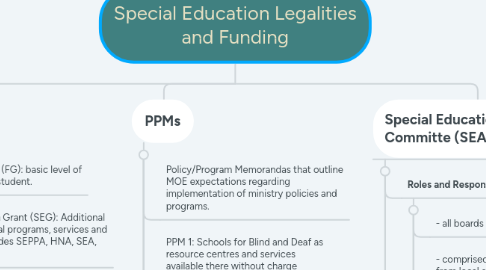Special Education Legalities and Funding
by Erin Baxter


1. Funding
1.1. Foundation Grant (FG): basic level of funding for each student.
1.2. Special Education Grant (SEG): Additional Funding for special programs, services and equipment. (Includes SEPPA, HNA, SEA, SIP, BEA, FA)
1.3. Special Education Per-Pupil Amount (SEPPA): Foundational special education funding.
1.4. High Needs Amount (HNA): Funding for additional staff support required for pupils with high needs.
1.5. Special Equipment Amount (SEA): Funding for essential equipment for pupils with special education needs.
1.6. Special Incidence Portion (SIP): Funding for staff for students that require more than 2 full-time staff in order to ensure health and safety of them and others.
1.7. Behaviour Expertise Amount (BEA): Funding to support board-level ABA expertise.
1.8. Facilities Amount (FA): Funding to provide instruction in a care, treatment, custody or correctional facility.
2. PPMs
2.1. Policy/Program Memorandas that outline MOE expectations regarding implementation of ministry policies and programs.
2.2. PPM 1: Schools for Blind and Deaf as resource centres and services available there without charge
2.3. PPM 8: outlines board requirements for identification and program planning for students with learning disabilities
2.4. PPM 11: boards are required to have procedures in place for early identification of strengths and needs
2.5. PPM 59: outlines best practices, roles and responsibilities and consent related to psychological testing
2.6. PPM 76C: outlines alternative educational program requirements and funding for deaf, blind and deaf-blind students
2.7. PPM 81: outlines roles and responsibilities of the ministries (MOE, MCSS, MOH) for in-school health support services
2.8. PPM 85: provides direction to school boards regarding the educational programs for students in CTCC facilities
2.9. PPM 140: provides direction to boards regarding the use of ABA for students with ASD
2.10. PPM 156: outlines requirements of transition plans
3. Special Education Advisory Committe (SEAC)
3.1. Roles and Responsibilities
3.1.1. - all boards are required to establish SEACs
3.1.2. - comprised of trustees and representatives from local associations
3.1.3. - make recommendations on all matters related to special education programs and services
3.1.4. - participate in the annual review of board Special Education Plan
3.1.5. - boards must provide personnel and facilities, as needed by the SEAC
3.1.6. - boards must provide the opportunity for SEAC to be heard before decisions about special education are made
3.2. Legislation
3.2.1. - laid out in Reg. 46/97 of the Education Act
3.3. Funding
3.3.1. - SEAC reviews financial statements of the board, as they relate to special education
3.3.2. - SEAC participates in the annual budget process, as it relates to special education

